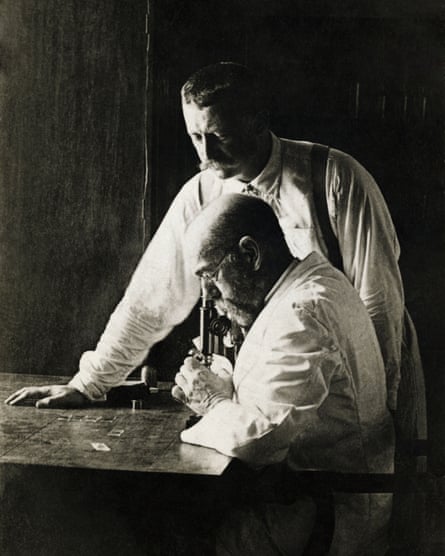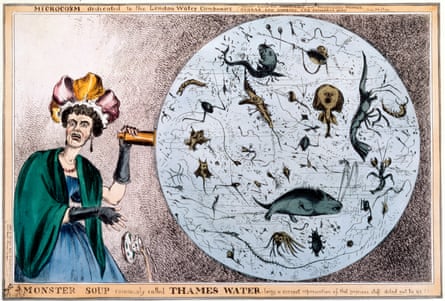Mohammad Shubo is motionless when he is wheeled into the clinic. He had started experiencing diarrhoea and vomiting that morning; by evening, he had no pulse.
In an effort to rehydrate him quickly, the nurses give Shubo an IV of saline solution. His reanimation seems almost uncanny – within half an hour he is able to sit up and speak. He spends the next two days at the hospital to rehydrate and convalesce before returning to his cramped quarters. If Shubo had arrived at the clinic just 10 minutes later he would have died, a nurse says.
For those who have been fortunate enough not to see the effects of cholera first hand, David Sack, a professor of international health at the Johns Hopkins University Bloomberg School of Public Health, says Shubo’s case, which appears on a 2011 Al Jazeera documentary, gives “a good sense of the disease”. Thousands of patients develop the same symptoms as Shubo did, though not all are as lucky. Sack recalls a case from Uganda in which a woman was hospitalised with symptoms of cholera, but the hospital staff didn’t diagnose her properly, even though there was a cholera treatment facility on the hospital grounds. She was not closely monitored and died of dehydration overnight. Cases like this should never happen, Sack says. But clearly they do.

In some parts of the world, including Europe and the US, cholera is so rare that it seems to have been eradicated. Some may see it as an “old world” disease, gone the way of the plague and smallpox. But it continues to devastate communities elsewhere, sometimes to pandemic proportions – an outbreak is raging in Yemen, where more than 246,000 cases and 1,500 deaths have been reported.
“Cholera is a brutal infection,” says Jason Harris, an associate professor of pediatrics at Massachusetts General Hospital. “Patients can go from looking healthy to dying quickly with cholera. It’s a scary disease.”
In the mid-1800s, as cholera swept across nearly every continent and killed thousands, scientists rushed to understand the disease. In 1854, a British doctor, John Snow, undertook the first epidemiological study that determined water from a pump on Broad Street was sickening Londoners with cholera (he didn’t discover the true reason why, however – at the time the disease was thought to be spread by miasma, not microbes). Then in 1884, a German researcher, Robert Koch, studied the intestines of deceased cholera patients in Egypt and India, concluding that the comma-shaped bacteria Vibrio cholerae he found there was the cause of the disease.

In the years since, scientists have figured out a lot more about the biology of cholera. Snow was correct: Vibrio cholerae is transmitted through contaminated water. Within as little as 12 hours or as long as five days, some people who have ingested the bacteria will start to show symptoms – uncontrollable vomiting and diarrhoea. But 80% of those who ingest the bacteria do not, possibly because of an existing immunity.
The scariest part of the disease, Harris says, is the sheer speed with which a patient can decline. If the condition isn’t treated quickly, people can die of dehydration within hours of showing symptoms.

“The amount of fluid loss from diarrhoea and vomiting [in patients] is shocking. It’s hard to believe unless you see it,” Harris says. It can be up to a litre per hour. And more people excreting the bacteria into water sources means more get infected, and it’s not hard to see how just a handful of cases could quickly balloon into an outbreak (there have been seven pandemics over the past two centuries), which can last decades.
The last pandemic started in Indonesia in the 1960s and spread across Asia and Africa before coming to Europe in 1973. By 1991, it had spread to Latin America, which had been free of cholera for more than a century. Around 400,000 reported cases and 4,000 deaths were reported in 16 countries of the Americas that year.
These days the disease does not have to be a death sentence. Doctors know how to treat cholera effectively. If a patient can reach a clinic in time, the treatment is fairly straightforward. With a rapid infusion of fluids and antibiotics, they are usually back to normal in a few days. There is also a vaccine, which is taken orally and can prevent infection in about 60% of people.
But this apparent simplicity is deceptive; all this knowledge isn’t the same as stopping the disease. “The map of cholera cases is pretty much a map of poverty,” says Dominique Legros, the team lead of the cholera group at the World Health Organization. “We still have cholera in places like Yemen because people don’t have access to safe water.” People living in poverty may know that drinking polluted water can get them sick, but they don’t have an alternative.
“Because of inequality and a lack of access to safe water and sanitation, more than a billion people are still at risk [of cholera],” Harris says.
So outbreaks continue. In some places, such as Zambia and Uganda, they are predictable, starting every year with the rainy season. But often, outbreaks can’t be anticipated. There are factors that can make an outbreak more likely – natural disasters can scatter infected people to contaminate more water sources and war can close clinics that might have helped citizens receive treatment or inhibit the import of necessary medication.

But these factors are hardly predictive. After the 2010 earthquake, for example, American epidemiologists concluded that Haiti was at low risk of a cholera outbreak; just a few months later, an epidemic was raging, in part because UN peacekeeping forces accidentally introduced the bacteria.
Years of political turmoil are fuelling the epidemic in Yemen. The situation is dire – the WHO estimates that nearly 250,000 people had been infected by the end of June, almost doubling previous estimates based on academic models. WHO officials are working with other non-profits and what remains of the national healthcare system to bring treatment to rural clinics to help people get treatment more quickly. This week, the International Coordinating Group allocated one million cholera vaccines to be sent to Yemen.

These strategies, along with education campaigns so people at risk of cholera know how to treat their water (by boiling, or with chlorine tablets), can reduce the incidence of the disease. But these advances don’t address the main problem: a lack of access to clean water. So the solution to eradicating cholera then, doesn’t lie in the health sector. “Yes, you need to treat patients and prevent death,” Legros says. “But the long-term solution is in the development sector – giving people long-term access to sanitation.”
There are some countries in which this may soon be possible. But in others, such as South Sudan and Somalia, the prospect of bringing safe water to the entire population seems remote.
Until the day when everyone has access to clean water and sanitation, researchers will work to answer more questions about the disease. One that remains is how – or if – Vibrio cholerae persists in the environment. “In places like Chad or on the western African coast, we see almost no cholera cases for several years, then there’s a big outbreak. It’s difficult to explain,” Legros says. “Some people say there is a reservoir in the environment that is maintained over years, though we don’t know how, and suddenly it erupts again, though again we don’t know how.” Harris also wonders about how the evolution of Vibrio cholerae may have affected its virulence and ability to cause pandemics.

As researchers work to answer these questions, and as nations move slowly towards improved infrastructure, public health officials will have to combat new outbreaks.
“I would hope that people appreciate how significant and serious a threat [cholera] is,” Harris says. “For people who think it’s a historical disease, they should know that it is still an important cause of morbidity and mortality around the world.”
Join our community of development professionals and humanitarians. Follow @GuardianGDP on Twitter.










Comments (…)
Sign in or create your Guardian account to join the discussion